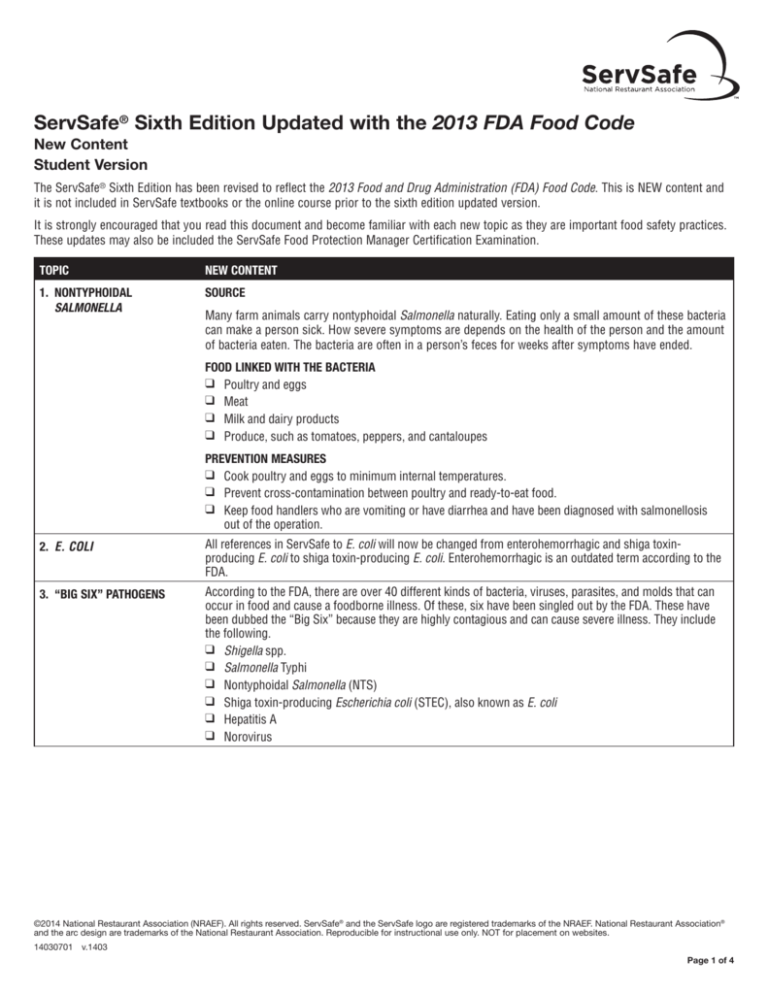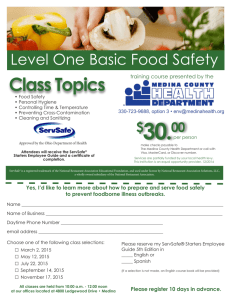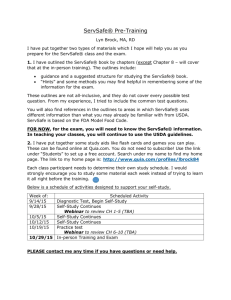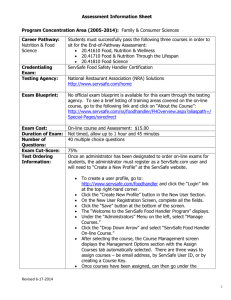
ServSafe® Sixth Edition Updated with the 2013 FDA Food Code
New Content
Student Version
The ServSafe® Sixth Edition has been revised to reflect the 2013 Food and Drug Administration (FDA) Food Code. This is NEW content and
it is not included in ServSafe textbooks or the online course prior to the sixth edition updated version.
It is strongly encouraged that you read this document and become familiar with each new topic as they are important food safety practices.
These updates may also be included the ServSafe Food Protection Manager Certification Examination.
TOPIC
NEW CONTENT
1.NONTYPHOIDAL
SALMONELLA
SOURCE
Many farm animals carry nontyphoidal Salmonella naturally. Eating only a small amount of these bacteria
can make a person sick. How severe symptoms are depends on the health of the person and the amount
of bacteria eaten. The bacteria are often in a person’s feces for weeks after symptoms have ended.
FOOD LINKED WITH THE BACTERIA
q Poultry and eggs
qMeat
q Milk and dairy products
q Produce, such as tomatoes, peppers, and cantaloupes
PREVENTION MEASURES
q Cook poultry and eggs to minimum internal temperatures.
q Prevent cross-contamination between poultry and ready-to-eat food.
qKeep food handlers who are vomiting or have diarrhea and have been diagnosed with salmonellosis
out of the operation.
2. E. COLI
All references in ServSafe to E. coli will now be changed from enterohemorrhagic and shiga toxinproducing E. coli to shiga toxin-producing E. coli. Enterohemorrhagic is an outdated term according to the
FDA.
3. “BIG SIX” PATHOGENS
According to the FDA, there are over 40 different kinds of bacteria, viruses, parasites, and molds that can
occur in food and cause a foodborne illness. Of these, six have been singled out by the FDA. These have
been dubbed the “Big Six” because they are highly contagious and can cause severe illness. They include
the following.
q Shigella spp.
q Salmonella Typhi
qNontyphoidal Salmonella (NTS)
q Shiga toxin-producing Escherichia coli (STEC), also known as E. coli
q Hepatitis A
qNorovirus
©2014 National Restaurant Association (NRAEF). All rights reserved. ServSafe® and the ServSafe logo are registered trademarks of the NRAEF. National Restaurant Association®
and the arc design are trademarks of the National Restaurant Association. Reproducible for instructional use only. NOT for placement on websites.
14030701 v.1403
Page 1 of 4
4. PATHOGEN PREVENTION
MEASURES
Shiga toxin-producing E. coli
Prevention Measures
qExclude food handlers who have diarrhea and have been diagnosed with an illness caused by the
bacteria from the operation.
q Cook food, especially ground beef, to minimum internal temperatures.
q Purchase produce from approved, reputable suppliers.
q Prevent cross-contamination between raw meat and ready-to-eat food.
Shigella spp.
Prevention Measures
qExclude food handlers who have diarrhea and have been diagnosed with an illness caused
by Shigella spp. from the operation.
q Wash hands.
q Control flies inside and outside the operation.
Hepatitis A.
Prevention Measures
q Exclude food handlers who have been diagnosed with hepatitis A from the operation.
q Exclude food handlers who have had jaundice for seven days or less from the operation.
q Wash hands.
q Avoid bare-hand contact with ready-to-eat food.
q Purchase shellfish from approved, reputable suppliers.
Norovirus
Prevention Measures
qExclude food handlers who are vomiting or have diarrhea and have been diagnosed with Norovirus
from the operation.
q Wash hands.
q Avoid bare-hand contact with ready-to-eat food.
q Purchase shellfish from approved, reputable suppliers.
5. GLOVE USE
Wash your hands before putting on gloves when starting a new task. You do not need to rewash your
hands each time you change gloves as long as you are performing the same task, and your hands have
not become contaminated.
6. BARE-HAND CONTACT
WITH READY-TO-EAT FOOD
There are times when it may be acceptable to handle ready-to-eat food with bare hands.
This is true in the following situations.
qThe food will be added as an ingredient to a dish that does not contain raw meat, seafood, or poultry,
but will be cooked to at least 145°F (63°C). For example, adding cheese to pizza dough.
qThe food will be added as an ingredient to a dish containing raw meat, seafood, or poultry, and the dish
will be cooked to the required minimum internal temperature of the raw item(s). For example, adding
vegetables to a beef stew.
©2014 National Restaurant Association (NRAEF). All rights reserved. ServSafe® and the ServSafe logo are registered trademarks of the NRAEF. National Restaurant Association®
and the arc design are trademarks of the National Restaurant Association. Reproducible for instructional use only. NOT for placement on websites.
14030701 v.1403
Page 2 of 4
7. HANDLING STAFF ILLNESSES Exclude the food handler from the operation if:
The food handler is vomiting or has diarrhea and has been diagnosed with an illness caused by one of
these pathogens.
qNorovirus
q Shigella spp.
qNontyphoidal Salmonella
q Shiga toxin-producing E. coli
Exclude the food handler from the operation if:
The food handler has been diagnosed with an illness caused by one of these pathogens.
q Hepatitis A
q Salmonella Typhi
8. LABELING FOOD PACKAGED
ON-SITE FOR RETAIL SALE
Food packaged in the operation that is being sold to customers for use at home, such as bottled salad
dressing, must be labeled. The label must include the following information.
q Common name of the food or a statement that clearly identifies it.
q Quantity of the food.
qList of ingredients and sub-ingredients in descending order by weight. This is necessary if the item
contains two or more ingredients.
q List of artificial colors and flavors in the food. Chemical preservatives must also be listed.
q Name and place of business of the manufacturer, packer, or distributor.
qSource of each major food allergen contained in the food. This is not necessary if the source is already
part of the common name of the ingredient.
These labeling requirements do not apply to customers’ leftover food items placed in carry-out containers.
9. THAWING ROP FISH
Frozen fish may be supplied in reduced-oxygen packaging (ROP). This fish should usually remain frozen
until ready for use. If this is stated on the label, the fish must be removed from the packaging at the
following times.
q Before thawing it under refrigeration.
q Before or immediately after thawing it under running water.
10. PARTIAL COOKING DURING
PREPARATION
Some operations partially cook food during prep and then finish cooking it just before service. You must
follow the steps below if you plan to partially cook meat, seafood, poultry, or eggs; or dishes containing
these items.
1. Do not cook the food for longer than 60 minutes during initial cooking.
2. Cool the food immediately after initial cooking.
3. Freeze or refrigerate the food after cooling it. If refrigerating the food, make sure it is held at 41°F
(5°C) or lower.
4. Heat the food to its required minimum internal temperature before selling or serving it.
5. Cool the food if it will not be served immediately or held for service.
©2014 National Restaurant Association (NRAEF). All rights reserved. ServSafe® and the ServSafe logo are registered trademarks of the NRAEF. National Restaurant Association®
and the arc design are trademarks of the National Restaurant Association. Reproducible for instructional use only. NOT for placement on websites.
14030701 v.1403
Page 3 of 4
11.REFILLING RETURNABLE
TAKE-HOME CONTAINERS
Some jurisdictions allow food handlers to refill take-home containers brought back by a customer with
food and beverages. Take-home containers can be refilled if they meet the following conditions.
q They were designed to be reused.
q They were provided to the customer by the operation.
q They are cleaned and sanitized correctly.
Take-home beverage containers can also be refilled as long as the beverage is not a TCS food and the
container will be refilled for the same customer. The container must also meet the following conditions.
q It can be effectively cleaned at home and in the operation.
q It will be rinsed before refilling with fresh, hot water under pressure.
qIt will be refilled by staff in the operation or by the customer using a process that prevents contamination.
12.HIGH-TEMPERATURE
DISHWASHING MACHINES
Operations using high-temperature dishwashing machines must provide staff with an easy and quick
way to measure surface temperatures of items being sanitized. The method used must provide an
irreversible record of the highest temperature reached during the sanitizing rinse. This ensures that the
dishwasher can reach correct sanitizing temperatures during operation. Maximum registering
thermometers or heat sensitive tape are good tools for checking temperatures.
13.CLEANING UP AFTER
PEOPLE WHO GET SICK
If a person has diarrhea or vomits in the operation, these spills must be cleaned up correctly. Vomit and
diarrhea can carry Norovirus, which is highly contagious. Correct cleanup can prevent food from
becoming contaminated. It will also keep others from getting sick. Check with your local regulatory
authority regarding requirements for cleaning up vomit and diarrhea. In many jurisdictions, a written
cleanup plan may be required.
©2014 National Restaurant Association (NRAEF). All rights reserved. ServSafe® and the ServSafe logo are registered trademarks of the NRAEF. National Restaurant Association®
and the arc design are trademarks of the National Restaurant Association. Reproducible for instructional use only. NOT for placement on websites.
14030701 v.1403
Page 4 of 4






![Diagnostic Test with Answers - [[Organization]] | [[City, State](http://s3.studylib.net/store/data/008716390_1-5ad1090ead536445864bad7794a982d6-300x300.png)